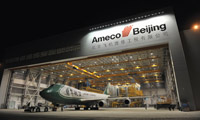Special Report: MRO Asia-Pacific update
OEMs flexing more muscle in MRO market
The maintenance, repair and overhaul (MRO) landscape is in the midst of significant change as original equipment manufacturers (OEMs) continue to expand their presence and power in the aftermarket. But some experts are warning airlines to be cautious before leaping into long-term service agreements with aircraft and engine manufacturers because it could be a costly decision.
May 1st 2013
Strategic, operational and maintenance consulting service, TeamSAI, has a powerful piece of advice for airlines about to purchase new aircraft or engines: make any after-sale service a part of the purchase negotiations before agreeing to a deal. That, said the U.S. consultancy, is the best time to leverage a cost advantage. Read More »
 |
| 'OEMs have the intellectual property, but MROs have the local knowledge and can execute' |
| Mark Hayman Director of Engineering Hong Kong Aircraft Engineering Company (HAECO) |
Why? According to TeamSAI, in a commentary on its world fleet and MRO forecast released last month, OEM designs have a major influence on the life cycle cost of an aircraft and its components driving critical factors such as performance, reliability and maintenance costs.
“Technological advances in airframe, engine, component, and systems design afford OEMs a very strong bargaining position when it comes to addressing and supporting maintenance and service life of fleets,” said the TeamSAI commentary.
“Indeed, OEMs now view product life cycle revenue to include initial sale, replacement parts, repair services and inventory support.”
The bottom line: OEMs today have a strong position relative to the airline customer and other service providers and have come to recognize the value of the aftermarket in terms of their own revenue and margins.
For airlines, however, TeamSAI says reliance on OEMs for life cycle cost forecasts can be risky. “It is imperative that operators truly understand the projected maintenance costs of any equipment they are considering,” it said.
“Relying on OEMs, after entry into service, to provide more data or tooling, which they likely consider intellectual property, is not enough. The operator lacks leverage at this point, because the aircraft is already accumulating required maintenance. The best opportunity to negotiate an advantage is during the aircraft purchase negotiation process.
“Operators should compare costs between similar fleets and obtain independent assessments of total ownership expenditure before making ultimate purchase decisions. Armed with information, operators will be in a better position to negotiate maintenance programme rates.”
 |
| Ameco Beijing: among the MROs capitalizing on the trend of the aviation industry moving east to make the best of growing markets |
Understanding the maintenance market and the varying costs of maintenance “will go far in ensuring operators obtain the best deals and maintain some level of control”, it added.
The warning comes as MROs continue to show healthy growth despite global economic trends and the rapid expansion of fleets with new technology aircraft, which ultimately require less maintenance.
Asian MROs are fast expanding as the centre of gravity of global aviation continues to move eastwards and major firms such ST Aerospace in Singapore, China’s Ameco Beijing, TAECO and GAMECO, as well as HAECO in Hong Kong, continue to expand their facilities.
TeamSAI’s latest forecasts predict the global MRO market will be worth $56.2 billion this year and will grow at an average of 3.1% to reach $76 billion annually by 2023.
However, in Asia, growth is expected to reach as much as 7% annually. The region’s share of MRO activity, currently worth about $11.5 billion, will rise from around 20% to 30% during the period, with a value of around $21 billion.
The growing power of OEMs in the market remains a hot topic of conversation. Mark Hayman, director of engineering for Hong Kong Aircraft Engineering Company (Haeco), which has joint ventures with various OEMs in the region, told an MRO Asia conference in Singapore late last year that more OEM involvement in the aftermarket is a natural progression from the start of airline maintenance outsourcing to third parties.
The changing roles of OEMs and MROs in the aftermarket are a cause for concern to some industry observers, although no one denies an evolution is under way, he said.
 |
| Pierre Reville, Vice-President Customer Support, Airbus: Teaming and choice are key. Airbus did not win by being the most expensive |
Hayman urged MROs to look at the evolution of the car market. “Companies used to buy a fleet of the same cars, but it evolved to where leasing companies like Hertz and Avis now manage the process and no longer charge by the mile,” he said.
“Look at what other industries are doing and it’s clear where we are going. OEMs have the intellectual property, but MROs have the local knowledge and can execute.”
Hayman argued this makes for a complementary relationship, as long as both deliver better on-wing reliability and maximize asset value for customers. “It’s about changing contracts to incentivize desired activities and performance,” he said.
Airbus and Boeing both insist it is their customers who want them to be more involved in supporting their aircraft after delivery, although they also stress that to a great degree they are doing this by working with MRO partners.
Pierre Reville, Airbus’ vice-president customer support, told the Singapore conference he believed the trend of airlines asking for aftermarket services will increase, partly because OEMs have the intellectual property to be able to drive a high reliability rate and be accountable for achieving them.
Some MRO providers and airlines suggest OEM solutions are more expensive and don’t take into account local labour and service costs. Reville said Airbus respected market conditions and did not win by being the most expensive. “Teaming and choice are key,” he said.
Despite the continual expansion of MRO facilities in Asia, some commentators point to persistant issues with the potential to cause problems.
Firstly, as with other areas of airline and aviation operations, such as cockpit crew, there are concerns about the industry’s ability to produce sufficient numbers of trained engineers to meet MRO requirements.
Asia is beginning to lose its labour cost advantage because pay rates in the region are rising. According to TeamSAI, the Asia-Pacific and China saw the greatest upward pressure on labour rates in the past year, followed by Latin America and the Caribbean.
“China’s rate increase continues to bring it more on par with that of developed regions, but also makes it potentially less attractive for outsourcing from other regions because of the smaller rate differential,” said the TeamSAI commentary.
Shortcomings are also beginning to emerge in MRO capacity. Wayne Plucker, aerospace industry manager for Frost & Sullivan, said for North American and European MROs, the market would be focused on an ageing widebody fleet. There should be a steady demand for their services for at least the next three years, he said.
“We are seeing a pick-up in spending on MRO for the older widebodies, which are now approaching a period of refurbishments and modifications, along with regularly scheduled maintenance, but unlike the narrowbody area MRO capacity could become an issue,” said Plucker.
“There isn’t the excess capacity that you have with narrowbodies, especially for the B747s and A380s, so scheduling is going to become an issue. For the A330 and B777, MRO capacity is becoming especially tight in the Asia-Pacific region.”
Asia-Pacific airlines operate more than 1,200 widebodies. This compares with 1,100 operating in North America, more than 800 in Europe and 600 in the Middle East.
A recent study revealed that North American operators will account for the majority of heavy maintenance checks in the next two years, with about 170 annually. By 2015, North America will drop to third place behind Asia and Europe, with approximately 130 heavy checks per year. The Asia-Pacific shows steady growth with 120 and 150 heavy checks annually in 2013 and 2014, increasing to more than 190 in 2015.
The future, as Mike McBride, principal and chief financial officer of TeamSAI puts it, is tightened relationships with the OEMs, increased focus on efficiency, high utilization of flexible working hours and process innovations, continued investments in facilities, training and new products and product improvement.
He said MROs have to decide what they want to be: either “go big” and target full-service capabilities or “go deep” and target small, niche areas for high-skill/high-value expertise and partner with others to build a full-service network.
The composition of airline fleets is changing, he pointed out, and MROs will have to strengthen their relationships with OEMs to ensure their technological competencies are maintained as well as exploring opportunities for new revenue streams.